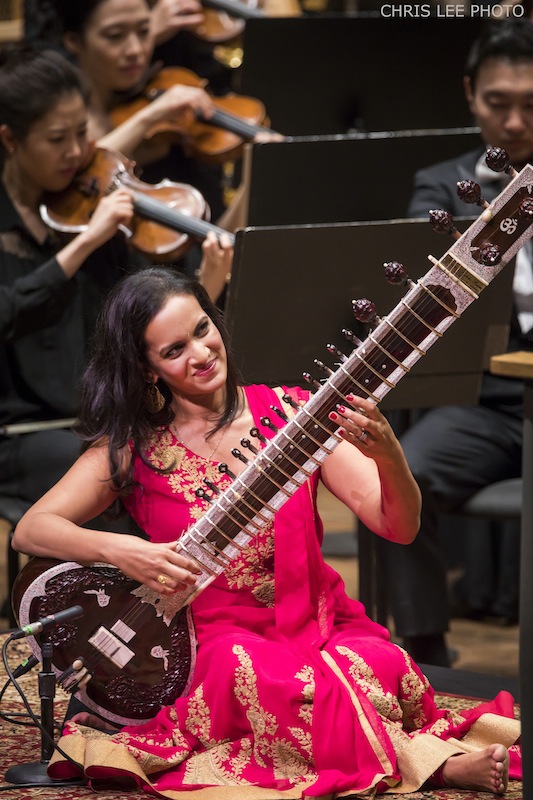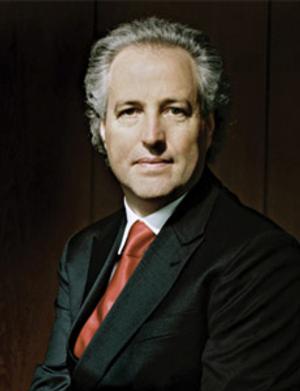Anoushka Shankar shines in father’s sitar concerto with Honeck, Philharmonic

Anoushka Shankar performed Ravi Shankar’s “Rāgā-Mālā” with Manfred Honeck and the New York Philharmonic Friday night. Photo: Chris Lee
If this week’s performances by the New York Philharmonic of Ravi Shankar’s Rāgā-Mālā (Garland of Ragas), A Concerto for Sitar and Orchestra aren’t quite the sentimental occasion the orchestra had planned, on Friday night the musical results proved satisfying indeed.
The substitution of the Austrian conductor Manfred Honeck for the ailing Zubin Mehta as concerto partner to the composer’s daughter, sitarist Anoushka Shankar, had the effect of training the spotlight even more on the engaging work itself.
Ravi Shankar, whose performances on the sitar and cross-cultural collaborations put India’s traditional music on the international music map in the 1960s and ‘70s, worked with Mehta to create the piece in 1979-80, when the latter was music director of the Philharmonic.
According to contemporary accounts, Shankar, who understood Western classical music but never learned its notation, got to know the orchestra’s principal players and their instruments, then dictated his musical ideas to composer José Luis Greco, who along with Mehta offered suggestions to improve the piece’s effect.
What his collaborators clearly didn’t do was try to wrap Shankar’s fragrant ragas in lush, post-Straussian orchestral sound. On Friday night, one heard the Indian master dipping into his Western paint box an instrument or a section at a time, combining them in endlessly inventive ways, and tossing the players fast, gnarly solos that were every bit as jaw-dropping as Anoushka Shankar’s on the sitar.
In fact, the senior Shankar’s famously modest demeanor was evident in the solo part for sitar, which came off as more collaborative with the orchestra than competitive in the Western concerto style. That deeply expressive instrument seemed to really stretch its wings only in the work’s cadenzas, imaginatively improvised by Anoushka Shankar with percussion accompaniment.
As anyone who attended one of Ravi Shankar’s hour-long explorations of a single raga will attest, his inspirations have their own sense of time. Friday’s audience heard a work in four movements that extended nearly an hour without benefit of the kind of harmonic and contrapuntal framework Western composers use, and they seemed to love it anyway, thanks to the composer’s agile imagination.
The concerto’s movements were modeled less on the Western four-movement scheme (fast-slow-scherzo-finale), than on Ravi Shankar’s own way of building an improvisation, each piece beginning with thoughtful, exploratory music, gaining momentum in the middle, and finishing with a blaze of virtuosity and rhythmic drive.
The third movement in particular drove to the finish amid such a clangor of industrial-sounding percussion that the audience burst into excited applause, as if it were the end of a three-movement concerto.
But the best was yet to come, as the Indian master mixed his orchestral salad one more time, to even greater effect. Drawing on no fewer than 20 different ragas—an Indian concept that combines the Western ideas of scale, melody, and mood, among other things—Shankar came up with a variety of musical textures that resembled Ravel’s tender Mother Goose one moment and Copland’s raucous Rodeo the next.
Anoushka Shankar, whose Grammy-nominated career has carried the family business to new cross-cultural heights, did her dad’s concerto proud, from lush meditations amid the gleam of the sitar’s drone strings to dazzling runs and leaps.

Manfred Honeck
Substituting for Mehta, the piece’s original exponent and dedicatee, Honeck gave a committed and energetic performance, apparently mastering the changing and overlapping Indian meters that can be such a puzzle to Western musicians and listeners.
At the concerto’s fortissimo close—possibly the only real orchestral tutti in the piece—the audience rose and cheered soloist, conductor, and the many orchestral players and sections whom Honeck called on for individual bows, all of them well earned.
Such a well-prepared performance on just a few days’ notice had to exact a price, and it came in the form of an out-of-focus run-through of Haydn’s Symphony No. 93 in D major. The evidently underrehearsed orchestra had difficulty even keeping together, much less realizing Haydn’s inspired ideas and quicksilver changes of mood. A suspenseful introduction to the first movement and a lively, alert finale were the bright spots.
Honeck closed the program with a deliberate performance of Schubert’s “Unfinished” Symphony No. 8 that emphasized the score’s dark shadows, hesitations and enigmas. It was an effective argument, although drawing out the close of the Andante to Mahlerian dimensions seemed like trying to put a finish on the “Unfinished.”
The program will be repeated 8 p.m. Saturday. nyphil.org; 212-875-5656.


